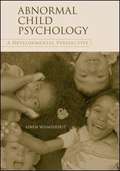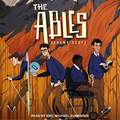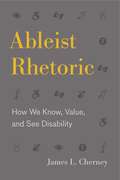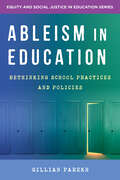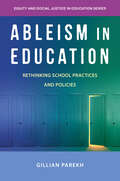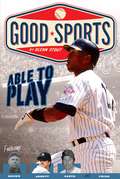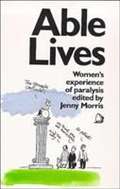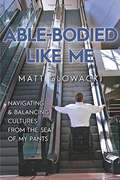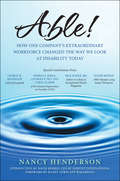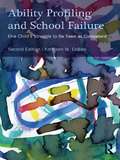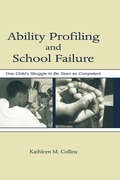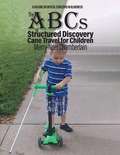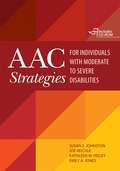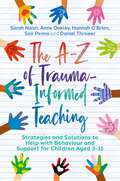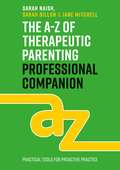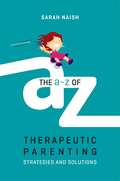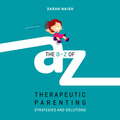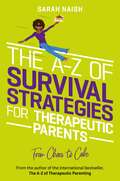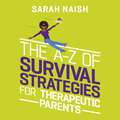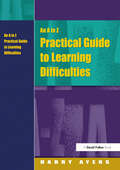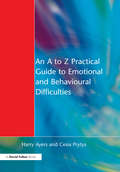- Table View
- List View
Abnormal Child Psychology: A Developmental Perspective
by Linda WilmshurstAbnormal Child Psychology: A Developmental Perspectiveis intended for undergraduate and Masters-level students enrolled in courses in Abnormal Child and Adolescent Psychology. Written from a developmental perspective, the book is organized around five prominent and recurring themes: the course of normal development proceeds in an orderly and predictable direction; maladaptive behaviors represent deviations from the normal path; maladaptive behavior is represented by a continuum of severity (symptoms, syndromes, disorders) based on the degree to which behaviors deviate from the norm; individual, interpersonal, contextual and cultural factors interact in a reciprocal way to influence normal development and abnormal deviations; theoretical input from diverse perspectives can guide our understanding of underlying processes that precipitate and maintain behaviors and the different developmental pathways that might result. The text provides students with a learning model which incorporates three essential cornerstones, which are pivotal to understanding child and adolescent psychopathology: the K3 paradigm that consists of knowledge of developmental expectations, knowledge of the sources of influence, and knowledge of the theoretical models. Each chapter opens with a case illustration to highlight the themes of the material that follows. The chapters conclude with a Summary Review, Glossary of New Terms and a Set of Review Questions.
The Ables
by Jeremy ScottI did have fantastic hearing, mostly by virtue of being blind. But that couldn't actually mean that he's trying to tell me I have super powers, right? Because that would be ridiculous. <p><p> It wasn't the "sex talk" he expected. Phillip Sallinger's dad has told him he's a custodian - a guardian - and his genetically inherited power is telekinesis. He'll learn to move objects with his mind. He's excited to begin superhero high school until he discovers he's assigned to a "special ed" class for disabled empowered kids; he suddenly feels like an outsider. Bullied, threatened, and betrayed, Phillip struggles, even as he and his friends - calling themselves the Ables - find ways to maximize their powers to overcome their disabilities, and are the first to identify the growing evil threatening humanity. As vital custodians disappear and the custodian leadership is mired in indecision, a mysterious and powerful figure taunts Phillip, and the enemy is poised to strike. But what if the next "one who does all," the multi-gifted custodian predicted to come, is one of the Ables? <p><p> The Ables is a fast-paced, captivating debut novel from Jeremy Scott, a bold, new voice in fantasy and science fiction.
Ableist Rhetoric: How We Know, Value, and See Disability (RSA Series in Transdisciplinary Rhetoric #11)
by James L. CherneyAbleism, a form of discrimination that elevates "able" bodies over those perceived as less capable, remains one of the most widespread areas of systematic and explicit discrimination in Western culture. Yet in contrast to the substantial body of scholarly work on racism, sexism, classism, and heterosexism, ableism remains undertheorized and underexposed. In this book, James L. Cherney takes a rhetorical approach to the study of ableism to reveal how it has worked its way into our everyday understanding of disability.Ableist Rhetoric argues that ableism is learned and transmitted through the ways we speak about those with disabilities. Through a series of textual case studies, Cherney identifies three rhetorical norms that help illustrate the widespread influence of ableist ideas in society. He explores the notion that "deviance is evil" by analyzing the possession narratives of Cotton Mather and the modern horror touchstone The Exorcist. He then considers whether "normal is natural" in Aristotle’s Generation of Animals and in the cultural debate over cochlear implants. Finally, he shows how the norm "body is able" operates in Alexander Graham Bell’s writings on eugenics and in the legal cases brought by disabled athletes Casey Martin and Oscar Pistorius. These three simple equivalencies play complex roles within the social institutions of religion, medicine, law, and sport. Cherney concludes by calling for a rhetorical model of disability, which, he argues, will provide a shift in orientation to challenge ableism’s epistemic, ideological, and visual components. Accessible and compelling, this groundbreaking book will appeal to scholars of both rhetoric and disability studies, as well as to disability rights advocates.
Ableist Rhetoric: How We Know, Value, and See Disability (RSA Series in Transdisciplinary Rhetoric)
by James L. CherneyAbleism, a form of discrimination that elevates “able” bodies over those perceived as less capable, remains one of the most widespread areas of systematic and explicit discrimination in Western culture. Yet in contrast to the substantial body of scholarly work on racism, sexism, classism, and heterosexism, ableism remains undertheorized and underexposed. In this book, James L. Cherney takes a rhetorical approach to the study of ableism to reveal how it has worked its way into our everyday understanding of disability.Ableist Rhetoric argues that ableism is learned and transmitted through the ways we speak about those with disabilities. Through a series of textual case studies, Cherney identifies three rhetorical norms that help illustrate the widespread influence of ableist ideas in society. He explores the notion that “deviance is evil” by analyzing the possession narratives of Cotton Mather and the modern horror touchstone The Exorcist. He then considers whether “normal is natural” in Aristotle’s Generation of Animals and in the cultural debate over cochlear implants. Finally, he shows how the norm “body is able” operates in Alexander Graham Bell’s writings on eugenics and in the legal cases brought by disabled athletes Casey Martin and Oscar Pistorius. These three simple equivalencies play complex roles within the social institutions of religion, medicine, law, and sport. Cherney concludes by calling for a rhetorical model of disability, which, he argues, will provide a shift in orientation to challenge ableism’s epistemic, ideological, and visual components. Accessible and compelling, this groundbreaking book will appeal to scholars of rhetoric and of disability studies as well as to disability rights advocates.
Ableism in Education: Rethinking School Practices And Policies (Equity and Social Justice in Education #0)
by Gillian ParekhHow we organize children by ability in schools is often rooted in ableism. Ability is so central to schooling—where we explicitly and continuously shape, assess, measure, and report on students’ abilities—that ability-based decisions often appear logical and natural. However, how schools respond to ability results in very real, lifelong social and economic consequences. Special education and academic streaming (or tracking) are two of the most prominent ability-based strategies public schools use to organize student learning. Both have had a long and complicated relationship with gender, race, and class. In this down-to-earth guide, Dr. Gillian Parekh unpacks the realities of how ability and disability play out within schooling, including insights from students, teachers, and administrators about the barriers faced by students on the basis of ability. From the challenges with ability testing to gifted programs to the disability rights movement, Parekh shows how ableism is inextricably linked to other forms of bias. Her book is a powerful tool for educators committed to justice-seeking practices in schools.
Ableism in Education: Rethinking School Practices and Policies (Equity and Social Justice in Education Series)
by Gillian ParekhHow we organize children by ability in schools is often rooted in ableism.Ability is so central to schooling—where we explicitly and continuously shape, assess, measure, and report on students’ abilities—that ability-based decisions often appear logical and natural. However, how schools respond to ability results in very real, lifelong social and economic consequences. Special education and academic streaming (or tracking) are two of the most prominent ability-based strategies public schools use to organize student learning. Both have had a long and complicated relationship with gender, race, and class.In this down-to-earth guide, Dr. Gillian Parekh unpacks the realities of how ability and disability play out within schooling, including insights from students, teachers, and administrators about the barriers faced by students on the basis of ability. From the challenges with ability testing to gifted programs to the disability rights movement, Parekh shows how ableism is inextricably linked to other forms of bias. Her book is a powerful tool for educators committed to justice-seeking practices in schools.
Able to Play: Overcoming Physical Challenges (Good Sports)
by Glenn StoutAble to Play shares the inspiring stories of four baseball players. Mordecai "Three Finger"Brown, Ron Santo, Jim Abbott, and Curtis Pride faced physical challenges other players didn't have. With determination and guts, they didn't just overcome; they excelled. This book is a game-changing celebration of overcoming odds.
Able Lives: Women's Experience of Paralysis
by Jenny MorrisThis is a book written by spinal cord injured women who want to share their experiences with newly injured women and their friends and relatives, and to impress our concerns upon the general public and professionals. It is part of a growing movement to bring disability issues which previously have been kept private - behind the closed doors of individual lives - out into the open. We hope there will be many more books like this one to follow.
Able-bodied Like Me: Navigating And Balancing Cultures From The Seat Of My Pants
by Matt GlowackiIn his insightful new memoir, Able-Bodied like Me, Matt Glowacki, civility speaker and author, chronicles the changing attitudes in our society—and in himself—about what it means to be disabled. <P><P>In the 1970s, when Glowacki was born, disabilities were still considered something to hide. Despite being born without legs, Glowacki pushed back against this narrative. He didn’t consider himself disabled and thought the term imposed unneeded limitations. He also balked at the tone-deaf remarks of others. He didn’t want to be an “inspiration” to people without impairments or a convenient way for others to signal their own virtue. Glowacki wanted to simply live his life, and he clearly explains how harmful certain remarks and actions can be for people in the disabled community. <P><P>In his memoir, Glowacki lists eighteen points to ponder as you reflect on your own assumptions and actions. Glowacki also examines his own changing beliefs about the term “disability,” as well as society’s shifting perspective. <P><P>As Glowacki shares the challenges he and others face in their everyday lives, he also offers suggestions about how to foster an environment of mutual respect and understanding. Glowacki certainly doesn’t want your pity. He just wants you to listen.
Able!: How One Company's Extraordinary Workforce Changed the Way We Look at Disability Today
by Nancy HendersonIn a time when companies are outsourcing abroad, Habitat International, a Tennessee-based carpet manufacturer, has managed to achieve superior levels of productivity at home, often two to three times greater than its competition. Habitat's business has grown enormously, with much of its new business coming from work outsourced to them by competitors who could not come close to matching its productivity.Habitat's secret: they hire the people no one else will.At Habitat three of every four workers have a physical or mental disability. They earn normal wages and are cross-trained on every job. They work harder, with less supervision, lower turnover and an unparalleled level of loyalty. The challenges have been significant; the rewards extraordinary.This is Habitat's story. It's a powerful and moving tale of personal courage, deep commitment and challenging expectations. It's a story of success and personal triumph. It'll change the way you think about business … and the people around you.
Ability Structure and Loss of Vision
by Jyrki JuurmaaPsychological testing of the ability structures of the blind and sighted was commenced almost simultaneously during the first decades of this century. However, a majority of the studies concerning the blind, and the most crucial among them, sought to develop IQ-type test batteries, intended mainly for appraising their school achievement. By contrast, systematic studies have not been carried out to explore the relationships among different, mutually relatively independent traits and the quantitative contributions of such traits to different test performances. This lack of interest is perhaps due to the narrow range of occupations regarded as suitable for the blind: there has been no acute need for a more differentiated picture.
Ability Profiling and School Failure: One Child's Struggle to be Seen as Competent
by Kathleen M. CollinsAbility Profiling and School Failure, Second Edition explores the social and contextual forces that shape the appearance of academic ability and disability and how these forces influence the perception of academic underachievement of minority students. At the book’s core is the powerful case study of a competent fifth grader named Jay, an African American boy growing up in a predominantly white, rural community, who was excluded from participating in science and literacy discourses within his classroom community. In this new edition, researcher and teacher-educator Kathleen Collins situates the story of Jay’s struggle to be seen as competent within current scholarly conversations about the contextualized nature of dis/ability. In particular, she connects her work to recent research into the overrepresentation of minority students in special education, exploring the roles of situated literacies, classroom interactions, and social stereotypes in determining how some students come to be identified as "disabled." Ability Profiling and School Failure, Second Edition comprises a thorough investigation into the socially constructed nature of ability, identity, and achievement, illustrating the role of educational and social exclusion in positioning students within particular identities.
Ability Profiling and School Failure: One Child's Struggle to Be Seen As Competent
by Kathleen M. Collins Kathleen M CollinsAbility Profiling and School Failure: One Child's Struggle to Be Seen as Competent explores the social and contextual forces that shape the appearance of academic ability and disability and how these forces influence the perception of academic underachievement of minority students. It is a powerful case study of a competent fifth grader, an African American boy growing up in a predominantly white, rural community, who was excluded from participating in science and literacy discourses within his classroom community. The case study form allows for the integration of the story of the student's struggle to be seen as competent in school, a context where his teacher perceives him as learning disabled, with Collins' own perspective as a researcher and teacher-educator engaged in a professional development effort with the teacher. The contribution of this book is to make visible the situated and socially constructed nature of ability, identity, and achievement, and to illustrate the role of educational and social exclusion in positioning students within particular identities. Highly relevant across the field of education, this book will particularly interest researchers, graduate students, and professionals in literacy and science education, curriculum and instruction, sociocultural theories of learning, discourse analysis of classrooms, research on teaching and learning, special education, social foundations, and teacher education.
The ABCs of Structured Discovery Cane Travel for Children (Critical Concerns In Blindness)
by Merry-Noel ChamberlainStructured Discovery Cane Travel (SDCT) is an Orientation and Mobility (O&M) curriculum which focuses on the foundational techniques necessary to develop future independence for students who are blind or visually impaired. The ABCs of Structured Discovery Cane Travel for Children addresses essential non-visual concept development, techniques and mobility skills needed to travel efficiently, gracefully and safely within a myriad of natural environments while using the long, white cane with a metal tip as the primary mobility tool. This curriculum utilizes transformational knowledge and problem-solving opportunities through teachable moments to develop personal reflection and mental mapping which can be utilized post instruction. These students maximize their cognitive intrinsic feedback while completing everyday mobility tasks. Parents and instructors of children who are blind or visually impaired will comprehend the essentials of SDCT by reading The ABCs of Structured Discovery Cane Travel for Children; in addition, they will receive a treasure trove of O&M skill-building activities.
Abandoned: Now Stutter My Orphan
by Jerry HalvorsonAbandoned reveals the design and the outcome of the Monster Study in which orphans were made to stutter.
The Abacus Made Easy: A Simplified Manual for Teaching the Cranmer Abacus
by Mae E DavidowFrom the book: At Overbrook, [School for the Blind] Dr. Davidow was instrumental in establishing the use of the Cranmer Abacus as a part of the regular curriculum. Her enthusiasm for this pioneer method of teaching mathematics led others to adopt the use of the abacus. In her role as coordinating teacher, she worked with the members of the Mathematics Department and the results were highly successful. Hopeful that this success at Overbrook might be experienced by many teachers elsewhere, she was encouraged to write this manual. Her goal was to write a clear, simple manual which could be used by teachers or students. This book represents her achievement.
AAC Strategies For Individuals With Moderate To Severe Disabilities
by Susan S. Johnston Joe Reichle Kathleen M. Feeley Emily A. JonesWith more children and young adults with severe disabilities in today's general education classsrooms, SLPs and other professionals must be ready to support their students' communication skills with effective AAC. They'll get the proven strategies they need with this intervention guide from top AAC experts, ideal for use as an in-service professional development resource or a highly practical text students will keep and use long after class is over. Essential for SLPs, OTs, PTs, educators, and other professionals in school settings, this book helps readers establish a beginning functional communicative repertoire for learners with severe disabilties. Professionals will start with an in-depth intervention framework, including a guide to AAC modes and technologies, variables to consider when selecting AAC, and how AAC research can be used to support practice. Then they'll get explicit, evidence-based instructional strategies they'll use to help children and young adults: initiate, maintain, and terminate an interaction; repair communication breakdowns; match graphic symbols to objects and events; request access to desired objects and activities; escape and avoid unwanted objects and activities; strengthen language comprehension and adaptive functioning; generalize communication skills across settings; and more. To help guide their interventions, professionals will get a CD-ROM with more than 35 forms on CD including: Checklist to Identify Potential Reinforcers; Intervention Planning Form; Performance Monitoring Forms; Task Analysis Development and Performance Monitoring Form; Checklist for Increasing Speed and Accuracy of Selection; and much more.
The A-Z of Trauma-Informed Teaching: Strategies and Solutions to Help with Behaviour and Support for Children Aged 3-11
by Sarah Naish Anne Oakley Hannah O'Brien Sair Penna Daniel Thrower"This is a remarkable achievement. Like Batman's Utility belt for teachers. So many practical, wise, inspiring, and achievable ideas are packed in here. I can imagine this becoming as indispensable for teachers as Gray's Anatomy is for doctors..." - Stephen Fry"If you want a book to assist with your work with traumatised children, choose this one. It is the best!" - Professor Peter Fonagy OBE, Chief Executive, Anna Freud National Centre for Children & Families"Humane and grounded in science, this book could change lives." - Sir Norman Lamb, Chair of Maudsley NHS and Children and Young People's Mental Health CoalitionWhat does trauma-informed teaching really look like in the classroom, and can we really achieve it?Maybe you, like many other teachers, will reach the end of a busy day feeling exhausted, deskilled and less than keen to dive into a book on the theory of trauma. Luckily you won't find any complex theory or jargon in this book, but you will gain an understanding of how small humans develop, how perplexing behaviours can be explained and learn inclusive strategies that will help all children in your classroom and school. Part 1 provides you with an explanation of what trauma-informed teaching involves. Then, Part 2 lists an A-Z of issues and behaviours for you to flip to in your busiest moments, ranging from Aggression and Lateness right through to Learning Challenges and Zzz (sleep issues). Gain new understanding into the children in your classroom with this book offering you strategies to better support every child's mental health and resilience.
The A-Z of Therapeutic Parenting Professional Companion: Tools for Proactive Practice (Therapeutic Parenting Books)
by Sarah Naish Sarah Dillon Jane MitchellDesigned as a professional complement to Sarah Naish's bestselling A-Z of Therapeutic Parenting, this tried and tested resource offers practical tools for all professionals supporting therapeutic families.Based on the latest research, and with photocopiable worksheets, pro formas and charts to use with parents, these tools will help you to build supportive and stable relationships with families and reduce family breakdown.The resource is structured into three parts:1. The Trauma Tracker Tool - designed to support the stability of the family and to predict possible incidents by providing an understanding of the presenting behaviours in the context of the child's history2. The Developmental Foundation Planner - to help professionals to identify and address unmet developmental needs in a structured way as soon as a child is placed with a family and thereby help reduce instances of family breakdown3. The Behaviour - Assessment of Impact and Resolution Tool (BAIRT) - which enables practitioners of most levels to engage in a step by step intervention, breaking down the most complex behaviours with a problem solving supportive process, thereby reducing the effects of blocked care and enabling engagement with parents in an honest, positive process. Simple to use, and easy to implement, these tools will enable you to create therapeutic, trauma-informed assessments, intervention and support.
The A-Z of Therapeutic Parenting: Strategies and Solutions (Therapeutic Parenting Bks.)
by Sarah NaishTherapeutic parenting is a deeply nurturing parenting style, and is especially effective for children with attachment difficulties, or who experienced childhood trauma. This book provides everything you need to know in order to be able to effectively therapeutically parent. Providing a model of intervention, The A-Z of Therapeutic Parenting gives parents or caregivers an easy to follow process to use when responding to issues with their children. The following A-Z covers 60 common problems parents face, from acting aggressively to difficulties with sleep, with advice on what might trigger these issues, and how to respond. Easy to navigate and written in a straightforward style, this book is a 'must have' for all therapeutic parents.
The A-Z of Therapeutic Parenting: Strategies and Solutions (Therapeutic Parenting Books)
by Sarah NaishThe complete guide to therapeutic parenting, with an A-Z of applied advice for 60 common issuesTherapeutic parenting is a deeply nurturing parenting style, and is especially effective for children with attachment difficulties, or who experienced childhood trauma. This book provides everything you need to know in order to be able to effectively therapeutically parent.Providing a model of intervention, The A-Z of Therapeutic Parenting gives parents or caregivers an easy to follow process to use when responding to issues with their children. The following A-Z covers 60 common problems parents face, from acting aggressively to difficulties with sleep, with advice on what might trigger these issues, and how to respond.Easy to navigate and written in a straightforward style, this book is a 'must have' for all therapeutic parents.(P) 2019 Hodder & Stoughton Ltd
The A-Z of Survival Strategies for Therapeutic Parents: From Chaos to Cake (Therapeutic Parenting Books)
by Sarah Naish'This book is your hot flask of tea or coffee, and a cosy blanket which will keep you warm, safe and well on your journey, ensuring you reach the other side, mentally and physically well.'So, you want to help your child by therapeutic parenting, but how are YOU?This easy-to-follow, dip-in dip-out resource addresses common challenges and feelings experienced by therapeutic parents and offers 80 practical strategies to help you cope and survive. Bestselling parenting author Sarah Naish writes with humour and compassion, sharing her personal and professional experiences covering all of the essentials: self-maintenance, coping with isolation and rejection, scheduling holidays and, of course, the therapeutic importance of cake!Think you don't have the time or inclination for a bit of 'self-care'? This book will save time, save energy and help solve your problems - a 'must have' for all therapeutic parents.
The A-Z of Survival Strategies for Therapeutic Parents: From Chaos to Cake (Therapeutic Parenting Books)
by Sarah NaishAn A-Z of how to take care of YOU - survival strategies and solutions to common challenges faced by therapeutic parents.'This book is your hot flask of tea or coffee, and a cosy blanket which will keep you warm, safe and well on your journey, ensuring you reach the other side, mentally and physically well.'So, you want to help your child by therapeutic parenting, but how are YOU?This easy-to-follow, dip-in dip-out resource addresses common challenges and feelings experienced by therapeutic parents and offers 80 practical strategies to help you cope and survive. Bestselling parenting author Sarah Naish writes with humour and compassion, sharing her personal and professional experiences covering all of the essentials: self-maintenance, coping with isolation and rejection, scheduling holidays and, of course, the therapeutic importance of cake!Think you don't have the time or inclination for a bit of 'self-care'? This audiobook will save time, save energy and help solve your problems - a 'must have' for all therapeutic parents.(P) 2022 Jessica Kingsley Publishers
An A to Z Practical Guide to Learning Difficulties
by Harry Ayers Francesca GrayAccessing up-to-date information about general and specific learning difficulties is made easy, with this indispensable reference book. Covering difficulties that relate to children, adolescents and adults, it includes: crucial legislation to keep practitioners 'in the know' useful addresses, telephone numbers and websites It also includes explanations of leaning difficulties including those less than well-known syndromes such as semantic pragmatic difficulties.
An A to Z Practical Guide to Emotional and Behavioural Difficulties
by Harry Ayers Cesia PrytysThe aim of this practical and user-friendly A to Z handbook is to enable the interested reader to gain quick and easy access to entries relating to or associated with emotional and behavioral difficulties. It focuses on adult problems as well as those of children and adolescents. The entries clearly and succinctly define and explain emotional behavioral terms and some of the different ways in which emotional and behavioral problems can be approached or treated. Where appropriate, entries are accompanied by a brief bibliography. Useful addresses and contact phone numbers are also provided where appropriate. This guide is useful for all teachers, mentors, social workers, educational social workers, educational psychologists, counselors, care workers, students and other professionals and voluntary workers in allied fields. It will also be of interest to parents and carers.
